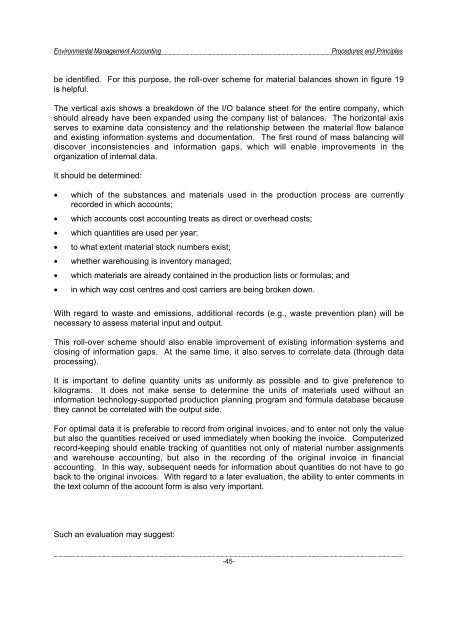Environmental Management Accounting Procedures and Principles
Environmental Management Accounting Procedures and Principles
Environmental Management Accounting Procedures and Principles
Create successful ePaper yourself
Turn your PDF publications into a flip-book with our unique Google optimized e-Paper software.
<strong>Environmental</strong> <strong>Management</strong> <strong>Accounting</strong><br />
<strong>Procedures</strong> <strong>and</strong> <strong>Principles</strong><br />
be identified. For this purpose, the roll-over scheme for material balances shown in figure 19<br />
is helpful.<br />
The vertical axis shows a breakdown of the I/O balance sheet for the entire company, which<br />
should already have been exp<strong>and</strong>ed using the company list of balances. The horizontal axis<br />
serves to examine data consistency <strong>and</strong> the relationship between the material flow balance<br />
<strong>and</strong> existing information systems <strong>and</strong> documentation. The first round of mass balancing will<br />
discover inconsistencies <strong>and</strong> information gaps, which will enable improvements in the<br />
organization of internal data.<br />
It should be determined:<br />
• which of the substances <strong>and</strong> materials used in the production process are currently<br />
recorded in which accounts;<br />
• which accounts cost accounting treats as direct or overhead costs;<br />
• which quantities are used per year;<br />
• to what extent material stock numbers exist;<br />
• whether warehousing is inventory managed;<br />
• which materials are already contained in the production lists or formulas; <strong>and</strong><br />
• in which way cost centres <strong>and</strong> cost carriers are being broken down.<br />
With regard to waste <strong>and</strong> emissions, additional records (e.g., waste prevention plan) will be<br />
necessary to assess material input <strong>and</strong> output.<br />
This roll-over scheme should also enable improvement of existing information systems <strong>and</strong><br />
closing of information gaps. At the same time, it also serves to correlate data (through data<br />
processing).<br />
It is important to define quantity units as uniformly as possible <strong>and</strong> to give preference to<br />
kilograms. It does not make sense to determine the units of materials used without an<br />
information technology-supported production planning program <strong>and</strong> formula database because<br />
they cannot be correlated with the output side.<br />
For optimal data it is preferable to record from original invoices, <strong>and</strong> to enter not only the value<br />
but also the quantities received or used immediately when booking the invoice. Computerized<br />
record-keeping should enable tracking of quantities not only of material number assignments<br />
<strong>and</strong> warehouse accounting, but also in the recording of the original invoice in financial<br />
accounting. In this way, subsequent needs for information about quantities do not have to go<br />
back to the original invoices. With regard to a later evaluation, the ability to enter comments in<br />
the text column of the account form is also very important.<br />
Such an evaluation may suggest:<br />
-45-




